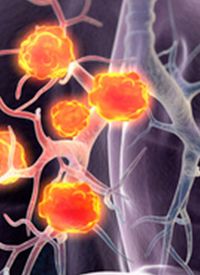News
Article
Sintilimab Plus Chemotherapy Improves PFS in Pretreated, EGFR-Mutant NSCLC
Author(s):
Sintilimab plus pemetrexed and cisplatin significantly improved progression-free survival vs pemetrexed and cisplatin alone in patients with advanced, EGFR-mutant non–small cell lung cancer who progressed on prior EGFR TKI therapy.

Sintilimab plus pemetrexed (Alimta) and cisplatin significantly improved progression-free survival (PFS) vs pemetrexed and cisplatin alone in patients with advanced, EGFR-mutant non–small cell lung cancer (NSCLC) who progressed on prior EGFR TKI therapy, according to data from the second interim analysis of the phase 3 ORIENT-31 trial (NCT03802240).1
At a median follow-up of 13.1 months, the median PFS was 5.5 months (95% CI, 4.5-6.1) with sintilimab plus chemotherapy vs 4.3 months (95% CI, 4.1-5.3) with placebo plus chemotherapy (HR, 0.72; 95% CI, 0.55-0.95; P = .0181).
“This is the first randomized, double-blind, placebo-controlled study that indicates significant PFS benefit with platinum-based doublet chemotherapy plus [an] anti–PD-1 antibody with or without [a] VEGF inhibitor vs chemotherapy alone,” lead study author Shun Lu, MD, PhD, of Shanghai Chest Hospital in China, and coauthors, wrote in a presentation shared during the 2022 ESMO Congress.
Treatment options remain poor for patients with advanced EGFR-mutant NSCLC who have progressed on EGFR TKIs.
The double-blind, multicenter trial evaluated sintilimab, with or without the bevacizumab (Avastin) biosimilar IBI305 plus chemotherapy in patients between the ages of 18 and 75 years who had received a diagnosis of histologically or cytologically confirmed, unresectable advanced or metastatic nonsquamous NSCLC. Patients needed to have an EGFR-mutated tumor, resistance to an EGFR TKI, no prior systemic therapy, and asymptomatic or stable brain metastases.
Patients were randomly assigned to 1 of 3 arms: 200 mg of intravenous sintilimab plus 15 mg/kg of the biosimilar, 75 mg/m2 of cisplatin, and 500 mg/m2 of pemetrexed every 3 weeks (arm A; n = 160); sintilimab plus pemetrexed, cisplatin, and placebo every 3 weeks (arm B; n = 160); or pemetrexed and cisplatin plus 2 placebos every 3 weeks (arm C; n = 160). All patients received 4 cycles of therapy before continuing to maintenance therapy.
Patients were stratified based on gender (male vs female) and whether brain metastases were present (yes vs no).
PFS comparing arms A and C and arms B and C served as the primary end point. Secondary end points included overall survival (OS), overall response rate (ORR), disease control rate (DCR), and duration of response (DOR).
Findings from the first interim analysis demonstrated a significant improvement in PFS in arm A vs arm C (HR, 0.46; 95% CI, 0.34-0.64; P <.0001).2
The data cutoff for the second interim analysis was March 31, 2022. The 2-sided superiority boundary for arm B vs arm C was an alpha of 0.0444.
The median age of patients in arm B was 57.5 years (range, 33-78) vs 56.0 years (range, 30-75) in arm C; 41.1% and 40.0% of patients, respectively, were male, and 36.7% vs 36.9%, respectively, had brain metastases. Moreover, 26.8% of those in arm B and 27.2% of those in arm C had T790M mutation positivity.
Additional results demonstrated improved ORR, DCR, and DOR with sintilimab. In arm B, the ORR was 34.8% (95% CI, 27.4%-42.8%) vs 29.4% (95% CI, 22.4%-37.1%) in arm C, translating to a rate difference of 5.3% (95% CI, -5.0% to 15.5%). The DCR was 81.6% (95% CI, 74.7%-87.3%) in arm B vs 75.6% (95% CI, 68.2%-82.1%) in arm C. The median DOR in arms A and B was 7.4 months (95% CI, 4.7-12.0) and 5.7 months (95% CI, 4.1-7.1), respectively.
Moreover, most subgroups benefitted from the addition of sintilimab, with the exception of patients with T790M mutations (HR, 1.10; 95% CI, 0.68-1.79) and those who received 2 lines of prior EGFR TKI therapy (HR, 1.30; 95% CI, 0.80-2.10).
The OS data were immature at the time of the second interim analysis.
Regarding safety, any-grade treatment-emergent adverse effects (TEAEs) were comparable between the arms, occurring in 96.8% of those in arm B vs 99.4% of those in arm C. Grade 3 or greater TEAEs were lower in arm B vs arm C, at 46.2% and 56.9%, respectively. The rates of serious events and those leading to death were also lower in arm B, at 26.3% and 1.3%, respectively, vs 30.6% and 3.1%, respectively, in arm C.
“The safety profile was acceptable without new unexpected safety signals,” the authors wrote.
Common toxicities in order of frequency included anemia, neutrophil count decrease, white blood cell count decrease, nausea, decreased appetite, asthenia, aspartate aminotransferase increase, vomiting, alanine aminotransferase increase, constipation, platelet count decrease, hypertension, weight decrease, blood creatinine increase, gamma-glutamyltransferase increase, and proteinuria.
Effects that led to treatment discontinuation occurred in 10.3% of patients in arm B vs 6.9% of those in arm C. Immune-related events occurred more commonly in arm B than arm C, at 26.3% and 15.6%, respectively.
References
- Lu S, Wu L, Jian H, et al. Sintilimab with or without IBI305 plus chemotherapy in patients with EGFR mutated non-squamous non-small-cell lung cancer (EGFRm nsqNSCLC) who progressed on EGFR tyrosine-kinase inhibitors (TKIs) therapy: second interim analysis of phase 3 ORIENT-31 study. Ann Oncol. 2022;33(suppl 7):S1424. doi:10.1016/j.annonc.2022.08.060
- Lu S, Wu L, Jian H, et al. Sintilimab plus bevacizumab biosimilar IBI305 and chemotherapy for patients with EGFR-mutated non-squamous non-small-cell lung cancer who progressed on EGFR tyrosine-kinase inhibitor therapy (ORIENT-31): first interim results from a randomised, double-blind, multicentre, phase 3 trial. Lancet Oncol. 2022;23(9):1167-1179. doi:10.1016/S1470-2045(22)00382-5









